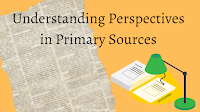Click here to read this mailing online.
Here are the latest updates for nurhasaan10@gmail.com "Free Technology for Teachers" - 3 new articles
Understanding Perspectives in Primary Sources - A New National Archives ResourceOnce they understood the difference between a primary and secondary source, helping students understand the context, meaning, and purpose of primary source documents was one of the things that I enjoyed the most when I taught U.S. History. To that end, I often used resources from the National Archives Daily Document RSS feed to spark conversations in my classroom. The National Archives recently published a new guide to help students understand perspectives in primary sources. Understanding Perspectives in Primary Sources (link opens a PDF) is a free guide that you can download and distribute to your students. The guide leads students through a series of questions designed to help them identify the type of primary source (writing, drawing, audio recording, etc.), who created it, and the context in which it was created (time, place). Applications for Education One of the most important aspects of the Understanding Perspectives in Primary Sources guide is in the last section. In that section students are asked, "what evidences does the creator present that you should fact check?" This is important because, in my experience, a lot of students assume that just because something is an old primary source it is therefore infallible as a source of information. The question that I would always ask my students to consider was, "does what you're reading line up with what you already know about this topic?" Science Friday is a Must-bookmark for Science TeachersScience Friday is a must-bookmark for teachers and students of science. As the name implies, every Friday a new batch of podcast segments about a wide range of science topics is released. Additionally, on Science Friday you will find interesting videos and articles about a wide array of topics in chemistry, biology, physics, space science, and much more. One of the segments that I liked from last week's Science Friday was this one about why a dog's breed may not be a great predictor of its behavioral traits. Applications for Education Science Friday offers lesson plans, many of them hands-on, that you can find in the education section of the site. To find a lesson plan just head to the education section of the site and then choose a grade level, subject, and STEM practice. The lesson plans include links to the national science standards addressed in the lesson. Lighting Up Celery Stalks is one of the featured biology lesson plans that I think students will enjoy. Gmail Settings to Avoid EmbarrassmentWe've all done it, you hit "send" on an email then realize you misspelled an important word or you click send and realize that you replied to all instead of just to the original sender. These situations can be either fairly innocuous or downright embarrassing depending upon who the email was sent to and or what was said. Fortunately, there are a couple of Gmail settings that can help you avoid these situations. Gmail has setting that allows you to unsend an email up to 30 seconds after it has been sent. Gmail also has a setting that lets you change the default reply behavior on group mailings. Both of these features are demonstrated in this video that I recently published on my YouTube channel. More Recent Articles |
Next
« Prev Post
« Prev Post
Previous
Next Post »
Next Post »


.png)


ConversionConversion EmoticonEmoticon